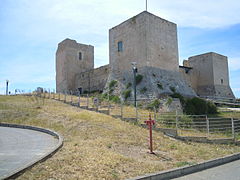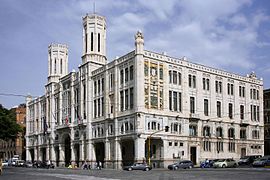Cagliari
![]()
This article is about the capital of Sardinia. For the DOC wine of the same name, see Cagliari (wine).
Cagliari (IPA: [![]()
![]() ˈkaʎʎari]; Latin Caralis; Sardinian Casteddu) is the largest city in Sardinia, capital of the autonomous Italian region of Sardinia, and capital of the Metropolitan City of Cagliari. The city itself has 153,231 inhabitants (as of 31 December 2019), and the agglomeration has about 470,000. The port city in the south of the island, on the shores of the Gulf of Cagliari, has a university, the Pontificia facoltà teologica della Sardegna, and is the seat of the Archbishopric of Cagliari.
ˈkaʎʎari]; Latin Caralis; Sardinian Casteddu) is the largest city in Sardinia, capital of the autonomous Italian region of Sardinia, and capital of the Metropolitan City of Cagliari. The city itself has 153,231 inhabitants (as of 31 December 2019), and the agglomeration has about 470,000. The port city in the south of the island, on the shores of the Gulf of Cagliari, has a university, the Pontificia facoltà teologica della Sardegna, and is the seat of the Archbishopric of Cagliari.
The old town of Cagliari is called Castello and is located on a hilltop overlooking the entire Gulf of Cagliari.
History
Karalis or Kalares was a Phoenician colony that later belonged to the Carthaginian Empire and came under Roman rule as a result of the First Punic War (lat. Caralis). During the Second Punic War, the city was the seat of a praetor and the most important Roman naval base in Sardinia. Later, the inhabitants were granted Roman citizenship. In the 4th century, the city was the episcopal see of Lucifer of Calaris. With the decline of the Western RomanEmpire, Cagliari fell into the hands of the Vandals. It then became part of the Byzantine Empire.
In the course of the weakening of the Byzantine rule over the island in the 9th century, five Sardinian Judicates (literally, magistracies) were initially formed. The Judiciary of Cagliari soon annexed the Judiciary of Agugliastra, and for centuries the island was divided into four Judicatories, which is also represented by its coat of arms. During this period of Sardinian independence, however, the city was abandoned by its citizens, as the Phoenician-Roman city, located directly on the sea, was raided several times by Moorish pirates. They founded the new city called Santa Igia further west inland.
With the strengthening of the Italian maritime republics, Pisa and Genoa competed for supremacy over Sardinia. Pisa brought Cagliari under its rule.
In the 14th century, the Pisan territory of Sardinia came into the possession of the Crown of Aragon through Pisa, and thus under Spanish administration through the Treaty of Tordesillas until the 17th century.
After passing from the Spanish to the Austrian Habsburgs for a short time, the Kingdom of Sardinia passed to the House of Savoy in 1718, which established the Kingdom of Sardinia-Piedmont. Thus it has belonged to Italy since 1861.

enlarge and show information about the picture
![]()
Panoramic view of Cagliari seen from the castle
Coat of arms
Description: The coat of arms is quartered with a red field at the top front and at the bottom back with a silver continuous cross and in the other fields in blue with a wave shield base on which a three-towered silver castle stands. Above the shield a golden leafy beaded crown and on a green ground to the sides are two skin-coloured male shield holders with a green head wreath and blue fish tails. The one on the right blows into a snail shell.

Aerial view of Cagliari
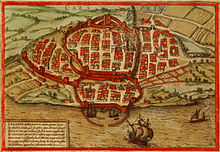
Cagliari in an illustration from 1572
Places of interest
Dom
The Cathedral of Cagliari, the Cathedral of Santa Maria di Castello, is the Episcopal Church of the Archdiocese of Cagliari and was originally built by the Pisans in the Romanesque-Pisan style from 1217. The church is a conglomeration of numerous alterations and additions, since as early as the 14th century alterations were made, such as the addition of the transept and changes to the façade. During the extensive baroque reconstruction from 1669 onwards, the Spaniards also built the baroque façade in 1702-1704, the remains of which are stored behind the Cathedral Museum. This was demolished in 1903 due to dilapidation and rebuilt in 1933 in the style of the Pisan Romanesque. The Pisan architrave of the main portal and the portals of the transept arms (Pisan to the north, Gothic to the south) are original. Above the lintel of the southern transept portal, the front wall of a Roman sarcophagus is walled in.
The interior of the cathedral is completely rebuilt in Baroque style. In addition to the ornate floor of colored marble, the silver chased and very finely chased tabernacle of 1610 from Palermo and the chased silver anpendium of 1655 from Madrid, the ceiling paintings, sacred sculptures and richly decorated tombs, the altarpiece "Retablo della Crocifissione" with a depiction of the Crucifixion and the enthroned Madonna from 1528/30 and the marble pulpit by the master sculptor Guglielmo, created between 1159 and 1162, are particularly worthy of mention. The latter was originally in Pisa Cathedral and was brought to Cagliari in 1312 as a gift from the Pisans for the Cathedral. The pulpit, cut in two during the Baroque reconstruction and moved to the west wall, with scenes from the life of Jesus, is considered one of the most outstanding works of Pisan art in Sardinia. Master Guillelmus is sometimes equated with Master William of Innsbruck, who is also said to have built the Leaning Tower of Pisa. Four stone lions, which originally supported four of the seven pulpit columns, now flank the stairs and the corners of the presbytery gallery in the crossing.
The crypt is worth mentioning. The vault is decorated with 600 rosettes, no two are alike. It houses burial chambers with the remains of almost 300 Sardinian martyrs who were transferred to the crypt from the church Basilica di San Saturno in the 17th century.
Basilica
The Basilica di Nostra Signora di Bonaria with its imposing baroque façade is a much-visited pilgrimage church and the Sardinian seat of the Mercedarian Order. From the sweeping flight of steps you have a wonderful view of the Golfo degli Angeli. The basilica was named Nostra Signora di Bonaria after a statue of the Madonna which, according to legend, was washed up here on a stormy night in 1370. When the people opened the box containing the figure, they were astonished to find that the candle in the Madonna's hands was still burning. Thus the Madonna became the patron saint of fishermen and sailors and eventually of the island of Sardinia.
Amphitheatre
Anfiteatro Romano dates back to the 2nd century BC and is the largest Roman building in Sardinia, covering about 1150 m². It was built directly into the hillside, the rows of seats are partially carved into the stone and supposedly offered space for up to 20,000 visitors, which was roughly equivalent to the total population of Cagliari at the time. The term "amphitheatre" indicates that the arena could be submerged by means of underground channels in order to perform - in addition to animal and human fights, theatrical performances and the like - the naval combat spectacles that were popular at the time.
The theatre had its heyday during the Roman Empire; later, from the Middle Ages to the period of Spanish rule, it was no longer used and fell into disrepair. In 1866 it was cleaned up and renovated, with additions such as aisles and rows of wooden seats, so that the archaeological site can still be used as a venue today. In the summer, concerts, festivals and musical performances are regularly held against this fantastic backdrop.
Towers
Torre dell'Elefante and Torre di San Pancrazio: Elefante Tower and Pancrazio Tower are part of the Pisan fortifications from the early years of the 14th century, works of the famous architect Giovanni Capula. Under the Spanish, the towers functioned as prisons, the open spaces in front of them supposedly as execution sites. For this purpose, the towers were also walled up on the fourth side and were not restored to their original state until 1906. Finally, in 1999, they were renovated again. Since then they have served as lookout towers.
The name "Elephant Tower" is derived from the small marble elephant above the gate. Why and since when it has been standing there is not clear. A second elephant portrait can be found at the top of the entrance stairs: it is a rough stone relief depicting a somewhat misshapen elephant.
The Torre San Pancrazio takes its name from a small church near the tower.
Bastione di Saint Remy
Popular with tourists and locals, the neoclassical-style square was built in 1901 on top of the old bastion from Piedmontese times as a panoramic terrace and meeting place for the urban population.
Other places of interest
- The churches of Santa Restituta, Sant'Efisio, Sant'Eulalia, San Saturno, San Giacomo
- The church of San Michele in the Stampace district is an excellent example of Catalan baroque architecture
- The Castello San Michele
- The Town Hall of Cagliari and Palazzo di Città (the former Town Hall in neo-Gothic style), Palazzo Viceregio (Viceregal Palace)
- The Botanical Garden (Orto Botanico di Cagliari): first opened in 1866, the Botanical Garden was destroyed during the Second World War and therefore completely rebuilt in the following years. The interestingly structured garden shows among other things native plants, medicinal plants, biblical plants, an extensive cactus collection as well as rare plants of the different continents. Furthermore, there are archaeological sites on the grounds, e.g. cisterns and a Roman cave. The park, which is accessible to the disabled, has several water features.
- The Spiaggia del Poetto, the beach southeast of Cagliari and south of the municipality of Quartu Sant'Elena (with 70,000 inhabitants), is almost seven kilometres long and five to a maximum of twelve kilometres from the centre of the city of Cagliari.
- The Saline di Quartu, a saline landscape in the Parco naturale regionale Molentargius of the metropolitan area of Cagliari, is located longitudinally between the beach of Poetto and the aforementioned urban settlements. The saline system is still maintained, but salt production ceased in 1984 due to contamination in the irrigation intakes. In this landscape, in times of active cultivation by the people, there was their residence called ''La città del Sale''. It includes a church called: "La chiesa del Santissimo nome di Maria", consecrated in 1934 but abandoned by the Roman Catholic Church in 1979.
· 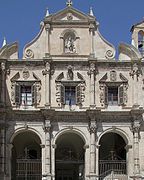
Chiesa di San Michele
·
Castello di San Michele
·
The town hall, the Palazzo Civico
· 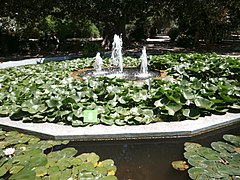
In the Botanical Garden
· 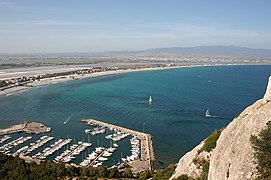
View of the beach of Cagliari: Il Poetto
· 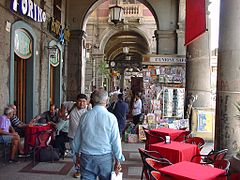
Arcades in Cagliari
· 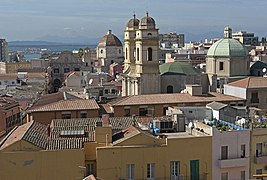
Cagliari, view in west direction
.JPG)
Basilica di Nostra Signora di Bonaria
,_Sardinia_(15939658843).jpg)
The amphitheatre

The cathedral in the old town Castello
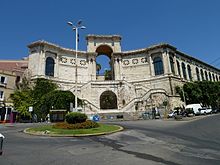
Bastione di Saint Remy
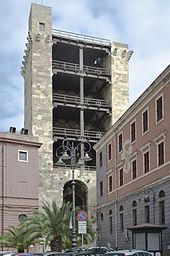
San Pancrazio Tower
Questions and Answers
Q: Where is Cagliari located?
A: Cagliari is located in the region of Sardinia in Italy.
Q: What is the capital of the Province of Cagliari?
A: Cagliari is the capital of the Province of Cagliari.
Q: What is the population of Cagliari?
A: There are 149,575 people living in Cagliari.
Q: What is the area of Cagliari?
A: The area of Cagliari is 85.45 km2 (32.99 sq mi).
Q: What is the population density of Cagliari?
A: The population density of Cagliari is 1,750.4 inhabitants/km².
Q: What are the comuni that border Cagliari?
A: The comuni that border Cagliari are Assemini, Capoterra, Elmas, Monserrato, Quartu Sant'Elena, Quartucciu, Selargius, and Sestu.
Q: What is the climate classification of Cagliari?
A: Cagliari has a hot-summer Mediterranean climate (Csa in the Koeppen climate classification).
Search within the encyclopedia
